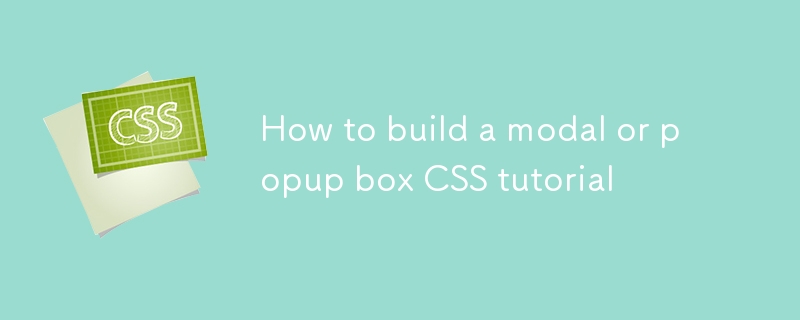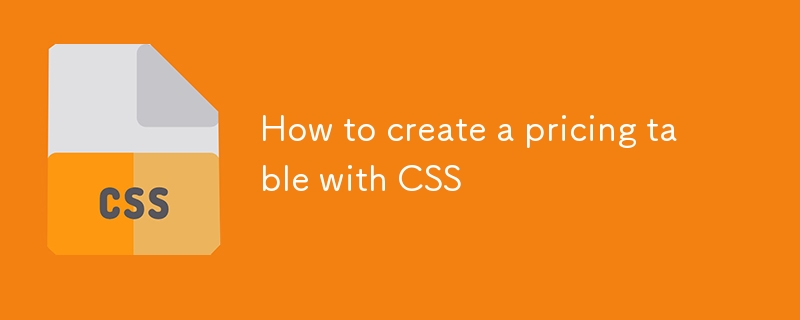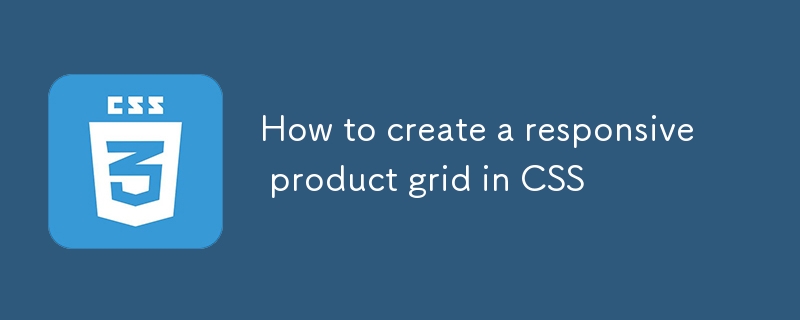Found a total of 10000 related content

How to create a navigation bar in HTML
Article Introduction:Use and create semantic navigation structures, and each link is wrapped with a wrapper tag; 2. Set list-style-type:none to remove bullets through CSS, float:left to achieve horizontal layout, padding and background-color beautify styles, and add hover effect with :hover; 3. Use media query @mediascreenand(max-width:600px) to set float:none to make navigation on small screens vertically stack, realizing basic responsive layout. A complete navigation bar needs to combine semantic HTML, CSS styles and responsive design to ensure complete functionality and adaptability to multiple devices.
2025-09-05
comment 0
381

How to create a simple image gallery with HTML5?
Article Introduction:Create a simple HTML5 image gallery only requires a basic HTML structure, and use div containers and img tags to add images in the body; 2. Use CSS to beautify the gallery through Flexbox or Grid layout, and set the image size, spacing, rounded corners, shadows and hover zoom effects; 3. Use media queries or responsive Grid layout to adapt the gallery to mobile devices; 4. Optionally use figure and figcaption to add titles and styles to the image; and finally achieve a simple, responsive image gallery without JavaScript.
2025-08-30
comment 0
271

How to create a mega menu in Bootstrap
Article Introduction:Use Bootstrap's drop-down menu and grid system to create a full-width pull-down content area; 2. Remove the default styles through custom CSS and set the container width to optimize the appearance; 3. Use responsive tools to hide or adjust the menu layout on the small screen; 4. Optionally add hover function through JavaScript, but pay attention to accessibility and touch device compatibility; finally achieve a complete, responsive and easy-to-use navigation menu through semantic HTML and reasonable structure.
2025-08-25
comment 0
419

How to create a multi-page website using HTML?
Article Introduction:The steps to create a multi-page website are as follows: 1. Plan the website structure, clarify the page content and list it; 2. Create an independent HTML file and add a unified navigation bar; 3. Set the link path correctly to ensure normal jumps; 4. Introduce public CSS files to maintain consistent style. Follow these steps to achieve a multi-page website with clear structure and complete functions.
2025-07-06
comment 0
189


How to create a footer in Bootstrap
Article Introduction:Create footers with Bootstrap can be achieved through containers, rows and column classes; 2. The basic footers use bg-dark, text-white and other practical classes to set styles; 3. Multi-column footers use grid layout to display links, contact information and other contents; 4. Sticky footers are always fixed at the bottom of the viewport through d-flex, flex-grow-1 and mt-auto; 5. Pay attention to semantic HTML, responsive design and accessibility to improve user experience, and finally select the appropriate structure according to website needs to complete the beautiful and functional footers.
2025-09-09
comment 0
731

How to build a modal or popup box CSS tutorial
Article Introduction:To create a basic modal box or pop-up box, first build the structure using HTML, then style it through CSS, and optionally implement interaction using JavaScript. 1. The HTML part includes trigger buttons, modal box containers and contents; 2. CSS is used to set positioning, overlaying and centering effects; 3. JavaScript controls display and hide; 4. Responsive design recommends using percentage width and media query to adapt to different devices. The whole process is simple and effective and is suitable for most simple scenarios.
2025-07-13
comment 0
763

How to build a portfolio website with Bootstrap?
Article Introduction:Set up the project structure and introduce BootstrapCDN; 2. Create a responsive navigation bar using Bootstrap components; 3. Design homepage, about, project and contact pages through Bootstrap grids and cards; 4. Add smooth scrolling and custom styles; 5. Test responsive effects and deploy websites on Netlify, GitHubPages or Firebase. Using Bootstrap can quickly build beautiful and responsive personal portfolio websites, without writing CSS from scratch, just focus on content and personalized adjustments to complete the deployment.
2025-09-10
comment 0
506

How to embed a YouTube video in HTML?
Article Introduction:To embed YouTube videos in web pages, just copy and paste the code provided by YouTube. First, open the target video, click the "Share" button, select "Embed" and copy the HTML code that appears, including the key src address and optional parameters such as allowfullscreen, autoplay, etc. Then paste the code in the appropriate location in the HTML file. If you use Jekyll or WordPress, you can also insert it into the custom HTML module. Finally, adjust the size, set a responsive design or add automatic playback parameters as needed?autoplay=1, note that the browser may restrict automatic playback with sound. Simple operation but attention should be paid to details to ensure complete functions and user body
2025-07-14
comment 0
947

How to create a pricing table with CSS
Article Introduction:The key to creating a responsive CSS pricing table is to use semantic HTML and Flexbox layouts. First, build the structure through div containers and plan boxes, then set the elastic layout, beautify the style and add recommendation logos with CSS. Finally, ensure mobile adaptation through media queries. The whole process is centered on clear visual hierarchy and concise design, and the implementation is complete and easy to expand.
2025-09-01
comment 0
320

How to set up the framework for bootstrap
Article Introduction:To set up the Bootstrap framework, you need to follow these steps: 1. Reference the Bootstrap file via CDN; 2. Download and host the file on your own server; 3. Include the Bootstrap file in HTML; 4. Compile Sass/Less as needed; 5. Import a custom file (optional). Once setup is complete, you can use Bootstrap's grid systems, components, and styles to create responsive websites and applications.
2025-04-07
comment 0
875

How to build a simple navigation bar in HTML
Article Introduction:Using HTML and CSS, you can easily create a simple navigation bar, first defining navigation links through semantic and structure, then using CSS to remove list symbols, set horizontal arrangements and hover effects, and finally achieve a clean and functional navigation bar that is suitable as the basic navigation component of any website.
2025-08-19
comment 0
592

Building Responsive Web Layouts with HTML
Article Introduction:The core of responsive web layout is to combine HTML and CSS to adapt the website to different devices. 1. Add viewport meta tags to ensure that the mobile device renders the page correctly; 2. Use Flexbox or Grid to create flexible layouts to automatically adjust elements; 3. Use media queries to set breakpoints and apply specific styles according to different devices; 4. Set pictures and containers to responsiveness to prevent content overflow; 5. Follow the mobile priority principle to improve development efficiency. After mastering these key points, responsive layout will be simpler and more efficient.
2025-07-18
comment 0
506

How to make a full-screen landing page with HTML and CSS
Article Introduction:To create a full-screen landing page, you need to use 100vh and Flexbox to implement it; 1. Set the HTML structure to include the landing page and subsequent content areas; 2. Use CSS to set the html and body height to 100%, the landing page height to 100vh, and use display:flex, justify-content:center and align-items:center to center; 3. Add background image and set background-size:cover to cover the full screen; 4. Optional optimizations include responsive fonts, hover effects, media query adaptation to the mobile terminal, and adding navigation bars or animations to enhance visual effects, ultimately realizing a simple and modern full-screen landing page
2025-08-23
comment 0
561

Top 10 formal and easy-to-use exchange platforms
Article Introduction:Want to trade with Gate.io? First, go to the official website to download the App or client, and pay attention to the authenticity of the official website! When registering, use your email/mobile phone number to set a strong password, turn on Google Verifier, and set a fund password. Complete KYC real-name authentication.
2025-03-26
comment 0
1059

SITE123: A Website Builder to Save Time and Money
Article Introduction:SITE123: Easy and convenient website construction platform, no programming experience required
SITE123 is a user-friendly and affordable website building platform that offers a variety of templates and features that allow you to easily create professional websites without any programming or design skills.
Key Advantages:
Free hosting and full set of features: SITE123 provides free website hosting, SEO tools, 24/7 customer support, powerful design tools, unlimited pages, responsive design, social media integration, and multilingual support.
Simple e-commerce features: Built-in easy-to-use online store builder, providing safe and reliable 24-hour operation guarantee, and is completely free.
Flexible paid solutions: Although free solutions are available, SITE123 also
2025-02-16
comment 0
1149

gate.io exchange official registration portal
Article Introduction:Gate.io is a leading cryptocurrency exchange that offers a wide range of crypto assets and trading pairs. Registering Gate.io is very simple. You just need to visit its official website or download the app, click "Register", fill in the registration form, verify your email, and set up two-factor verification (2FA), and you can complete the registration. With Gate.io, users can enjoy a safe and convenient cryptocurrency trading experience.
2025-02-20
comment 0
857

How to create a responsive product grid in CSS
Article Introduction:Use CSSGrid to create a responsive product grid, and implement adaptive layout through display:grid and grid-template-columns:repeat(auto-fit,minmax(250px,1fr)); 2. Set the gap attribute to ensure consistent project spacing; 3. Add styles to each product to form a card effect, including borders, rounded corners, margins and shadows; 4. Optionally use media queries to further control the number of columns under a specific screen size; 5. The complete example includes HTML structure, CSS layout and responsive design to ensure that it can be displayed well on different devices, and ultimately implement a screen change without JavaScript and CSS only
2025-08-15
comment 0
580

How to create a simple layout with HTML divs
Article Introduction:To create a simple HTML page layout, you need to follow the following steps: 1. Use the basic HTML structure, including the div elements of header, navbar, main (including sidebar and content) and footer; 2. Set the global style through CSS, use display:flex to make the sidebar and content sidebar side by side, flex:1 let the content adapt to the remaining space, and use box-sizing:border-box and min-height to ensure the stable layout; 3. Add @media query, and set main to vertical arrangement when the screen width is less than 768px to achieve responsive design. most
2025-08-01
comment 0
267


















